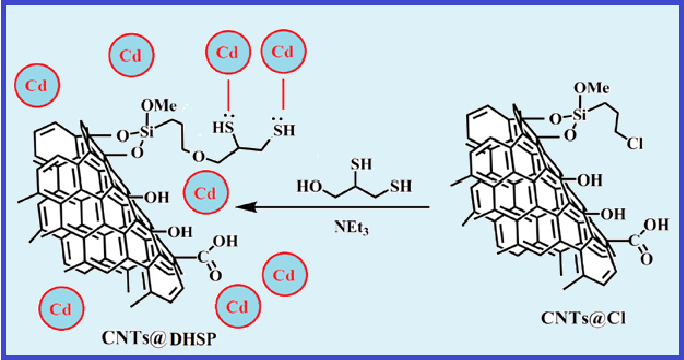Separation and determination of cadmium in water samples based on functionalized carbon nanotube by syringe filter membrane- micro solid-phase extraction
Volume 4, Issue 01, Pages 5-15, Mar 2021 *** Field: Analytical Environmental Chemistry
Abstract
A simple and fast separation of cadmium (Cd) based on functionalized carbon nanotubes with 2,3-dimercapto-1-propanol (CNTs@DHSP) was achieved in water samples before a determination by atom trap flame atomic absorption spectrometry (AT-FAAS). In this study, Cd(II) ions were extracted by syringe filter membrane-micro solid phase extraction procedure(SFM-μ-SPE). Firstly, 20 mg of the CNTs@DHSP as solid-phase added to 20 mL of water sample in a syringe, then dispersed for 3 min after adjusting pH up to 7 and pass through SFM very slowly. After extraction, the Cd(II) ions were back-extracted from SFM/CNTs@DHSP by 1.0 mL of eluent in acidic pH. Finally, the cadmium concentration was measured by AT-FAAS. Under the optimal conditions, the linear range (2–90 µg L−1), LOD (0.75 µg L−1) and enrichment factor (19.6) were obtained (RSD<1.5%). The adsorption capacity of Cd(II) with the CNTs@DHSP was obtained about 152.6 mg g-1. The method was validated by certified reference materials (SRM, NIST) and ET-AAS in water samples.
References
L.T. Friberg, G.G. Elinder, T. Kjellstrom, G.F. Nordberg, Cadmium and Health: A toxicological and epidemiological appraisal, CRC Press: Boca Raton, FL, USA, Vol. 2, 2019.
M.R. Rahimzadeh, S. Kazemi, A.A. Moghadamnia, Cadmium toxicity and treatment, Caspian J. Intern. Med., 8 (2017) 135–145.
A.A. Tinkov, T. Filippini, O.P. Ajsuvakovae, M.G. Skalnaya, J. Aasethf, G. Bjørklundh, E.R. Gatiatulinai, E.V. Popova, O.N. Nemereshinai, P.T. Huangk, Cadmium and atherosclerosis: A review of toxicological mechanisms and a meta-analysis of epidemiologic studies, Environ. Res., 162 (2018) 240–260.
M.S. Sinicropi, A. Caruso, A. Capasso, C. Palladino, A. Panno, C. Saturnino, Heavy metals: toxicity and carcinogenicity, Pharmacol., 2 (2010) 329–333.
S. Satarug, Dietary cadmium intake and its effects on kidneys, Toxics, 6 (2018) 15.
A.E. Nielsen, A. Bohr, M. Penkowa, The balance between life and death of cells: Roles of metallothioneins, Biomark. Insights, 1 (2007) 99–111.
G. Gobe, D. Crane, Mitochondria, reactive oxygen species and cadmium toxicity in the kidney, Toxicol. Lett., 198 (2010) 49–55.
T. Bora, J. Dutta, Applications of nanotechnology in wastewater treatment—A review, Nanosci. Nanotechnol., 14 (2014) 613–626.
L. Zhang, Q. Lei, Y. Cheng, Y. Xie, H. Qian, Y. Guo, Y. Chen, W. Yao, Study on the removal of cadmium in rice using microbial fermentation method, J. Food Sci., 82 (2017) 1467–1474.
International Agency for Research on Cancer (IARC), Monographs on the evaluation of the carcinogenic risks to human's beryllium, cadmium, mercury and exposures in the glass manufacturing Industry, scientific publications: Lyon, France, pp. 119–238, 1993.
World Health Organization(WHO), Evaluation of certain food additives and contaminants, Thirty-third report of the joint FAO/WHO expert committee on food additives, technical report series 776, 1989. http://www.who.int/ipcs/publications/jecfa/reports/en/index.html
N. Altunay, A. Elik, Ultrasound-assisted alkanol-based nanostructured supramolecular solvent for extraction and determination of cadmium in food and environmental samples: Experimental design methodology, Microchem. J., 164 (2021) 105958.
E. M. Angelin, M. Ghirardello, The multi-analytical in situ analysis of cadmium-based pigments in plastics, Microchem. J., 157( 2020) 105004.
V. MortazaviNik, E. Konoz, A. Feizbakhsh, A. A. M. Sharif, Simultaneous extraction of chromium and cadmium from bean samples by SrFe12O19@CTAB magnetic nanoparticles and determination by ETAAS: An experimental design methodology, Microchem. J., 159 (2020) 105588.
M. Arjomandi, H. Shirkhanloo, A review: Analytical methods for heavy metals determination in environment and human samples, Anal. Methods Environ. Chem. J., 2 (2019) 97-126.
H. Shirkhanloo, S. A. H. Mirzahosseini, N. Shirkhanloo, The evaluation and determination of heavy metals pollution in edible vegetables, water and soil in the south of Tehran, province by GIS, Arch. Environ. Prot., 41 (2015) 63-72.
M. Aliomrani, M.A. Sahraian, H. Shirkhanloo, M. Sharifzadeh, Blood concentrations of cadmium and lead in multiple sclerosis patients from Iran, Iran. J. Pharm. Res., 15 (4), 825 2016
J. Charoensuk, J. Thonglao, B. Wichaiyo, A simple and sensitive colorimetric sensor for cadmium (II) detection based on self-assembled trimethyl tetradecyl ammonium bromide and murexide on colloidal silica, Microchem. J., 160 (2021) 105666.
N. S.Medvedev, O. V. Lundovskaya, A. I. Saprykin, Direct analysis of high-purity cadmium by electrothermal vaporization-inductively coupled plasma optical emission spectrometry Microchem. J., 145 (2019) 721-755.
Y. Liu, Y. Chu, Z. Hu, S. Zhang, High-sensitivity determination of trace lead and cadmium in cosmetics using laser-induced breakdown spectroscopy with ultrasound-assisted extraction, Microchem. J., 158 (2020) 105322.
H. Kaw, J. Li, X. Jin, Ultrasound-assisted liquid–liquid spray extraction for the determination of multi-class trace organic compounds in high-volume water samples. Analyst, 143 (2018) 4575-4584.
E. Bidari, M. Irannejad, M. Gharabaghi, Solvent extraction recovery and separation of cadmium and copper from sulphate solution, J. Environ. Chem. Eng., 1 (2018) 1269–1274.
S.S. Swain, B. Nayak, N. Devi, S. Das, N. Swain, Liquid–liquid extraction of cadmium(II) from sulfate medium using phosphonium and ammonium based ionic liquids diluted in kerosene, Hydrometallurgy, 162 (2016) 63–70.
H. Shirkhanloo, M. Ghazaghi, M.M. Eskandari, Cloud point assisted dispersive ionic liquid-liquid microextraction for chromium speciation in human blood samples based on isopropyl 2-[(isopropoxycarbothiolyl) disulfanyl, Anal. Chem. Res., 10 (2016) 18-27.
M. Sadeghi, E. Rostami, D. Kordestani, H. Veisi, M. Shamsipur, Simultaneous determination of ultra-low traces of lead and cadmium in food and environmental samples using dispersive solid-phase extraction (DSPE) combined with ultrasound-assisted emulsification microextraction based on the solidification of floating organic drop (UAEME-SFO) followed by GFAAS, RSC Adv., 7 (2017) 27656–27667.
E. Yilmaz, I. Ocsoy, Bovine serum albumin-Cu(II) hybrid nanoflowers: An effective adsorbent for solid phase extraction and slurry sampling flame atomic absorption spectrometric analysis of cadmium and lead in water, hair, food and cigarette samples, Anal. Chim. Acta, 906 (2016)110-117.
samples, H. Shirkhanloo, A. Khaligh, F. Golbabaei, Z. Sadeghi, A. Vahid, A. Rashidi, On-line micro column preconcentration system based on amino bimodal mesoporous silica nanoparticles as a novel adsorbent for removal and speciation of chromium (III, VI) in environmental, J. Environ. Health Sci. Eng., 13 (2015) 1-12.
M. Ghazaghi, H. Z. Mousavi, A. M. Rashidi, H. Shirkhanloo, R. Rahighi, Innovative separation and preconcentration technique of coagulating homogenous dispersive micro solid phase extraction exploiting graphene oxide nanosheets Anal. Chim. Acta, 902 (2016) 33-42.
H. Shirkhanloo, A. Khaligh, H.Z. Mousavi, A. Rashidi, Graphene oxide-packed micro-column solid-phase extraction combined with flame atomic absorption spectrometry for determination of lead (II) and nickel (II) in water samples, Int. J. Environ. Anal. Chem., 95 (2015) 16-32.
M. B. Hossein Abadi, H. Shirkhanloo, J. Rakhtshah, The evaluation of TerphApm@MWCNTs as a novel heterogeneous sorbent for benzene removal from air by solid phase gas extraction, Arab. J. Chem. 13 (2020) 1741-1751.

Copyright (c) 2021 Analytical Methods in Environmental Chemistry Journal

This work is licensed under a Creative Commons Attribution 4.0 International License.
JOURNAL PUBLISHING AGREEMENT
PLEASE PROVIDE US THE FOLLOWING INFORMATION,
Article entitled:
Corresponding author:
To be published in the journal:
Your Status
I am the sole author of the manuscript
- I am an Iranian government employee.
- I am a European government employee
- I am a Asian government
- None of the above
I am one author signing on behalf of all co-authors of the manuscript
- I am an Iranian government employee.
- I am a European government employee
- I am a Asian government
- None of the above
Please tick the above blanks (as appropriate), review the Journal Publishing Agreement, and then sign and date the document in black ink.
Published Journal Article: the author may share a link to the formal publication through the relevant DOI. Additionally theses and dissertations which contain embedded Published Journal Articles as part of the formal submission may be hosted publicly by the awarding institution with a link to the formal publication through the relevant DOI. Any other sharing of Published Journal Articles is by agreement with the publisher only.
Signed: ______________________________________ Name printed: ___________________________________________
Title and Company (if employer representative): _______________________Date: __________________________________














